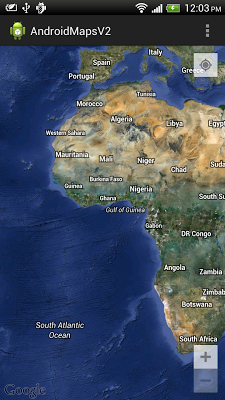package com.example.androidmapsv2;
import com.google.android.gms.common.ConnectionResult;
import com.google.android.gms.common.GooglePlayServicesUtil;
import com.google.android.gms.maps.GoogleMap;
import com.google.android.gms.maps.MapFragment;
import android.os.Bundle;
import android.app.Activity;
import android.app.AlertDialog;
import android.app.FragmentManager;
import android.app.FragmentTransaction;
import android.view.Menu;
import android.view.MenuItem;
import android.widget.Toast;
public class MainActivity extends Activity {
final int RQS_GooglePlayServices = 1;
private GoogleMap myMap;
MapFragment myMapFragment;
private static final String TAG_MYMAPFRAGMENT = "TAG_MyMapFragment";
@Override
protected void onCreate(Bundle savedInstanceState) {
super.onCreate(savedInstanceState);
//setContentView(R.layout.activity_main);
FragmentManager myFragmentManager = getFragmentManager();
myMapFragment =
(MapFragment)myFragmentManager.findFragmentByTag(TAG_MYMAPFRAGMENT);
if(myMapFragment == null){
myMapFragment = MapFragment.newInstance();
FragmentTransaction fragmentTransaction = myFragmentManager.beginTransaction();
fragmentTransaction.add(android.R.id.content, myMapFragment, TAG_MYMAPFRAGMENT);
fragmentTransaction.commit();
}
}
@Override
public boolean onCreateOptionsMenu(Menu menu) {
// Inflate the menu; this adds items to the action bar if it is present.
getMenuInflater().inflate(R.menu.activity_main, menu);
return true;
}
@Override
public boolean onOptionsItemSelected(MenuItem item) {
switch (item.getItemId()) {
case R.id.menu_legalnotices:
String LicenseInfo = GooglePlayServicesUtil.getOpenSourceSoftwareLicenseInfo(
getApplicationContext());
AlertDialog.Builder LicenseDialog = new AlertDialog.Builder(MainActivity.this);
LicenseDialog.setTitle("Legal Notices");
LicenseDialog.setMessage(LicenseInfo);
LicenseDialog.show();
return true;
}
return super.onOptionsItemSelected(item);
}
@Override
protected void onResume() {
super.onResume();
int resultCode = GooglePlayServicesUtil.isGooglePlayServicesAvailable(getApplicationContext());
if (resultCode == ConnectionResult.SUCCESS){
Toast.makeText(getApplicationContext(),
"isGooglePlayServicesAvailable SUCCESS",
Toast.LENGTH_LONG).show();
if(myMap == null){
myMap = myMapFragment.getMap();
if(myMap != null){
myMap.setMyLocationEnabled(true);
myMap.setMapType(GoogleMap.MAP_TYPE_HYBRID);
}else{
Toast.makeText(getApplicationContext(),
"cannot getMap!",
Toast.LENGTH_LONG).show();
}
}
}else{
GooglePlayServicesUtil.getErrorDialog(resultCode, this, RQS_GooglePlayServices);
}
}
}
The series:
A simple example using Google Maps Android API v2, step by step.

0 comments:
Post a Comment